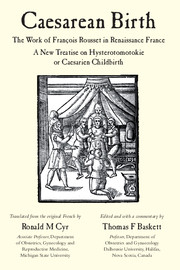 Caesarean Birth
Caesarean Birth Book contents
- Frontmatter
- Contents
- Acknowledgements
- Preface
- Translator's introduction
- François Rousset and the first text on caesarean section: a commentary by Thomas F Baskett
- A New Treatise on Hysterotomotokie or Caesarien Childbirth
- Sonnet
- Dedication
- Preface to the reader
- Part 1 Definition of caesarean childbirth
- Part 2 Second proof: logic (reason)
- Part 3 Third justification: expert opinion
- Part 4 Examples documenting other worse dangers from similar operations that are not caesarean
- Part 5 Other more popular justifications
- Part 6 On the fertility that remains after caesarean section
- A short guide to surgeons on the technique of caesarean
- Approbation
- Copyright
- Appendix 1 Summary of 16th century French history
- Appendix 2 Renée de France (1510–1575), Duchess of Ferrara, Chartres, Montargis and Nemours
- Appendix 3 Jacques de Savoie-Nemours (1531–1585), Duc de Nemours and Genevois
- Index
Part 6 - On the fertility that remains after caesarean section
Published online by Cambridge University Press: 05 June 2014
- Frontmatter
- Contents
- Acknowledgements
- Preface
- Translator's introduction
- François Rousset and the first text on caesarean section: a commentary by Thomas F Baskett
- A New Treatise on Hysterotomotokie or Caesarien Childbirth
- Sonnet
- Dedication
- Preface to the reader
- Part 1 Definition of caesarean childbirth
- Part 2 Second proof: logic (reason)
- Part 3 Third justification: expert opinion
- Part 4 Examples documenting other worse dangers from similar operations that are not caesarean
- Part 5 Other more popular justifications
- Part 6 On the fertility that remains after caesarean section
- A short guide to surgeons on the technique of caesarean
- Approbation
- Copyright
- Appendix 1 Summary of 16th century French history
- Appendix 2 Renée de France (1510–1575), Duchess of Ferrara, Chartres, Montargis and Nemours
- Appendix 3 Jacques de Savoie-Nemours (1531–1585), Duc de Nemours and Genevois
- Index
Summary
The fact that many of the women in the previous case histories who had suffered serious injury to the uterus – whether by caesarean section or by some more serious conditions – have since given birth, attests that fertility is wholly preserved after such operations. Notwithstanding this evidence, I expect that some readers will remain unconvinced, believing this to be impossible, for two plausible reasons. The first is nervous exhaustion of the uterus, thought to result from the alleged large loss of blood. I have already addressed this, having shown that even when haemorrhage is severe (which it is not), this particular blood is unnecessary – its presence a burden to a well-regulated organism, hence the salutary benefits arising from its removal. As for the defect resulting from incision or trauma (the second reason), it is very small after the uterus involutes following delivery of the child.
That the scar does not interfere with fertility
Having answered this objection, it might still be argued that even if, as we say, the incision site is very small, its scar will also be very short but thick, sclerotic and inelastic, given the large number of fibres haphazardly tangled up within it; as a result, the uterus, it is alleged, will be unable to stretch enough in that location to accommodate the child comfortably. According to them, either this will prevent conception, interfere with carrying to term, or inhibit the child's growth; this will also prevent delivery by reducing the force of uterine contractions during labour, which should be equal in all parts of the uterus.
- Type
- Chapter
- Information
- Caesarean BirthThe Work of François Rousset in Renaissance France - A New Treatise on Hysterotomotokie or Caesarian Childbirth, pp. 91 - 106Publisher: Cambridge University PressPrint publication year: 2010


